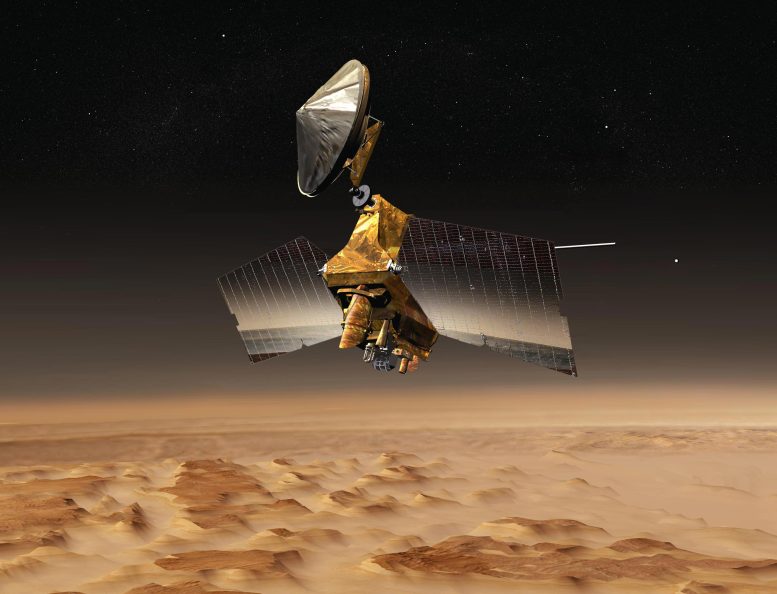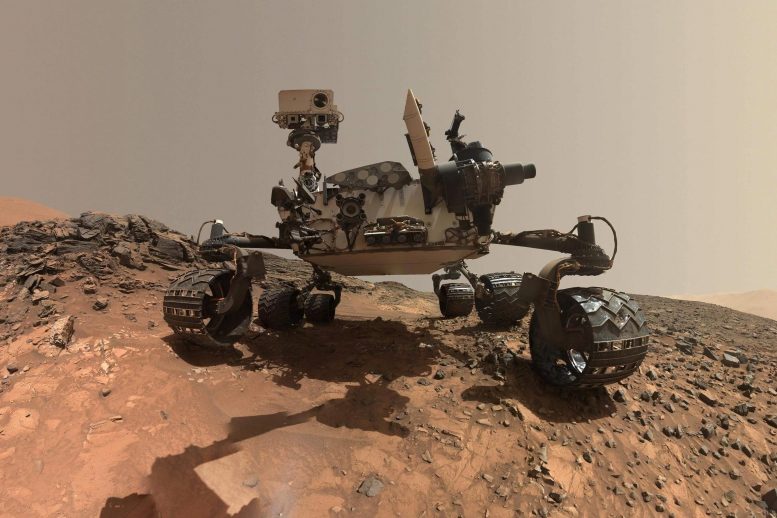
NASA’s Curiosity rover just made history with its first-ever mid-drive photo snapped from orbit, captured by the HiRISE camera aboard the Mars Reconnaissance Orbiter.
The image shows Curiosity trucking across the Martian surface, leaving a dramatic trail of tracks as it heads toward a mysterious region that could reveal ancient groundwater activity.
Curiosity Caught in Action From Orbit
NASA’s Curiosity Mars rover is no stranger to the camera, often appearing in selfies and images taken from orbit. But on February 28, the 4,466th Martian day, or sol, of its mission, Curiosity was captured in what is believed to be the first orbital image of the rover actively driving across the Red Planet.
The photo, taken by the HiRISE (High-Resolution Imaging Science Experiment) camera aboard NASA’s Mars Reconnaissance Orbiter, shows Curiosity as a small dark speck at the front of a long trail of rover tracks. Stretching about 1,050 feet (320 meters), these tracks are expected to remain visible for months before being erased by Martian winds. They mark roughly 11 separate drives beginning on February 2, as Curiosity moved at a top speed of 0.1 mph (0.16 kph) from the Gediz Vallis channel toward its next science target — a region thought to feature “boxwork” rock formations, possibly created by ancient groundwater activity billions of years ago.

Navigating Mars: Curiosity’s Daily Challenges
How quickly the rover reaches the area depends on a number of factors, including how its software navigates the surface and how challenging the terrain is to climb. Engineers at NASA’s Jet Propulsion Laboratory in Southern California, which leads Curiosity’s mission, work with scientists to plan each day’s trek.
“By comparing the time HiRISE took the image to the rover’s commands for the day, we can see it was nearly done with a 69-foot drive,” said Doug Ellison, Curiosity’s planning team chief at JPL.

Black-and-White Surprise in Latest Snapshot
Designed to ensure the best spatial resolution, HiRISE takes an image with the majority of the scene in black and white and a strip of color down the middle. While the camera has captured Curiosity in color before, this time the rover happened to fall within the black-and-white part of the image.
In the new image, Curiosity’s tracks lead to the base of a steep slope. The rover has since ascended that slope since then, and it is expected to reach its new science location within a month or so.
More About Curiosity and MRO
NASA’s Curiosity rover is a car-sized robotic explorer designed to study the geology, climate, and potential habitability of Mars. Built at NASA’s Jet Propulsion Laboratory (JPL) — which is managed by Caltech in Pasadena, California — Curiosity has been investigating the Red Planet since its dramatic landing in 2012. Managed by JPL for NASA’s Science Mission Directorate, the rover is part of the broader Mars Exploration Program portfolio, contributing critical insights into Mars’ ancient environment and helping to pave the way for future human missions.
NASA’s Mars Reconnaissance Orbiter (MRO) has been orbiting Mars since 2006, using its suite of powerful instruments to study the planet’s atmosphere, surface, and underground layers. Operated by JPL for NASA’s Science Mission Directorate, MRO supports the Mars Exploration Program by relaying data for surface missions and capturing high-resolution imagery. One of its key instruments, the HiRISE (High-Resolution Imaging Science Experiment) camera, is operated by the University of Arizona and was built by BAE Systems in Boulder, Colorado. HiRISE has provided some of the most detailed views of Mars ever obtained from orbit.
Never miss a breakthrough: Join the SciTechDaily newsletter.
1 Comment
Not to change the subject but why does NASAput a camera on a nearby space object